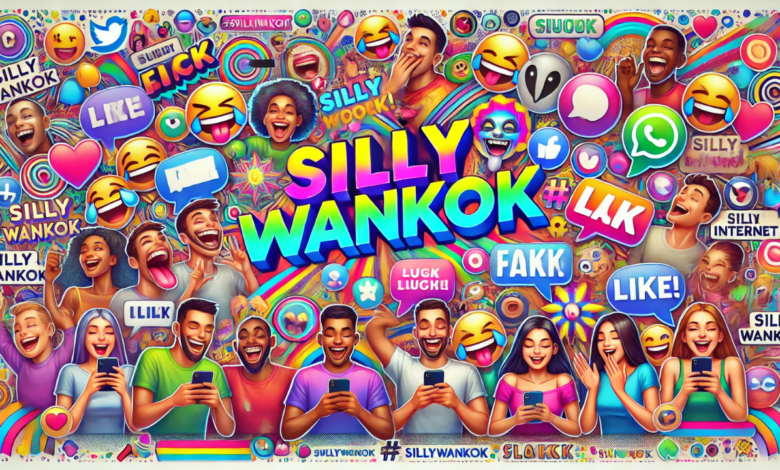Embracing the Absurd: The Rise of Silly Wankok in Internet Culture

Silly Wankok has emerged as a symbol of absurd humor and whimsical interaction in the ever-evolving landscape of internet memes and social media trends. This article explores the origin, popularity, and cultural significance of Silly Wankok, tracing its journey from a nonsensical phrase to a viral sensation embraced across various digital platforms.
The Origin of Silly Wankok
Silly Wankok began as an internet meme, a seemingly random collection of words that captivated the online community with its quirky and comedic sound. Originating from the depths of meme culture, the phrase quickly gained traction on platforms like Twitter, TikTok, and Instagram, where users reveled in its playful absurdity. The exact origin remains as mysterious and elusive as the phrase itself, adding to its charm and enigmatic appeal.
The Mechanics of a Meme: Why Silly Wankok?
What makes Silly Wankok stand out in the crowded world of online trends? Firstly, its phonetic appeal makes it memorable and fun to say, lending itself easily to repetitive use and creative adaptations. Additionally, its inherent absurdity provides a stark contrast to the often severe tone of everyday discourse, offering a lighthearted escape for people of all ages.
Cultural Impact and Popularity
As Silly Wankok spread, it transcended its status as just another internet meme. It began to influence conversations, media content, and even marketing strategies. Comedians, content creators, and brands adopted the phrase, incorporating it into sketches, videos, and advertising campaigns, eager to connect with a younger, internet-savvy demographic.
Silly Wankok in Everyday Language
More than just a digital phenomenon, Silly Wankok has infiltrated everyday language. It is often used to describe bizarre or hilarious situations, serving as a modern-day equivalent of calling something a “wild ride” or “a series of unfortunate events.” Its versatility makes it a handy tool for adding humor and spontaneity to online and offline conversations.
Psychological Appeal: Why We Love the Absurd
The popularity of Silly Wankok taps into a more profound psychological need for humor and fun. In a world burdened by challenges and complexities, embracing the absurd provides a mental break and fosters a sense of community among those in the know. This shared laughter entertains and builds connections as people come together to revel in the silliness.
Impact on Marketing and Media
Recognizing its appeal, marketers and media professionals have leveraged Silly Wankokto attract attention and engage audiences. Its usage in advertising is particularly noteworthy, as it demonstrates the power of memes in contemporary marketing strategies. By injecting humor and relatability into campaigns, brands resonate more with their target markets.
The Role of Influencers and Celebrities
Influencers and celebrities have significantly amplified Silly Wankok’s reach. By incorporating the phrase into their content and social media interactions, they have endorsed its use and encouraged their followers to do the same. This celebrity endorsement has significantly boosted the phrase’s popularity, cementing its status as a staple of internet vernacular.
Challenges and Critiques
Despite its popularity, Silly Wankok has faced criticism from some quarters. Critics argue that its nonsensical nature might contribute to a decline in the quality of discourse and oversimplify complex conversations. However, supporters contend that its role is purely for entertainment and should not be overanalyzed for deeper meaning.
The Future of Silly Wankok
Silly Wankok’s future is still being determined, as is any internet trend. While it might eventually fade into the background as new memes emerge, its impact on internet culture and meme evolution will likely be studied and appreciated for years to come. Whether it remains a staple of online humor or becomes a nostalgic reference, Silly Wankok has already left its mark.
Conclusion
Silly Wankok is more than just a phrase; it’s a cultural phenomenon highlighting internet culture’s whimsical and unpredictable nature. By exploring its origins, impact, and significance, we gain insight into the mechanisms of viral trends and the communal joy they can bring. As digital landscapes continue to evolve, the legacy of Silly Wankok will remind us of the power of humor to unite and delight even in the most unexpected ways.
FAQS on Silly Wankok
What is Silly Wankok?
Silly Wankok is a playful and nonsensical phrase originating from internet meme culture. It describes or reacts to absurd and humorous situations, often capturing the whimsical and unpredictable nature of online interactions.
How did Silly Wankok become popular?
The phrase gained popularity through social media platforms such as TikTok, Twitter, and Instagram, where it was used in various humorous contexts. Its catchy, fun nature made it easy for people to adopt and share, contributing to its viral spread.
Where is Silly Wankok commonly used?
Silly Wankok is commonly used across various digital platforms, including social media, online forums, and video content. It’s often featured in memes, casual conversations, and even marketing materials to inject humor and attract a young, internet-savvy audience.
Can Silly Wankok be used in professional settings?
While Silly Wankok is excellent for informal and lighthearted interactions, its use in professional settings should be cautiously approached. It’s best suited for environments or contexts where casual and playful communication is appreciated.
Why do people enjoy using Silly Wankok?
People enjoy using Silly Wankok because it adds a light and playful element to communication. It allows individuals to connect over shared humor and serves as a brief escape from more severe or mundane aspects of life.



